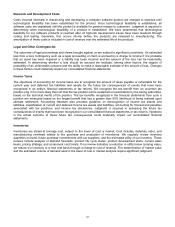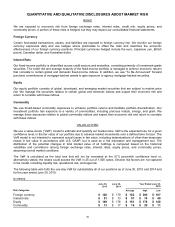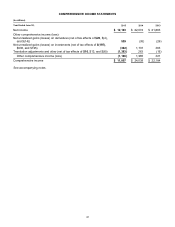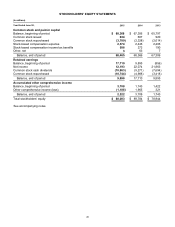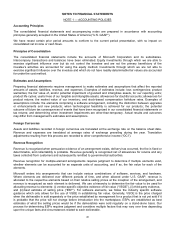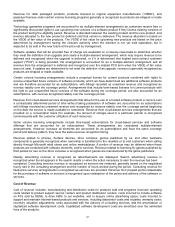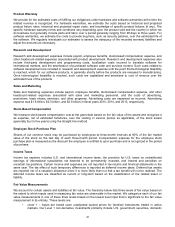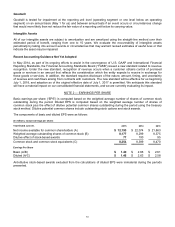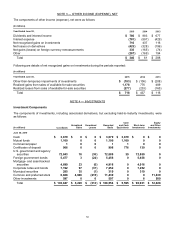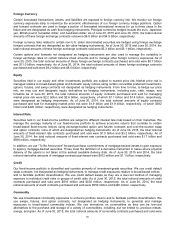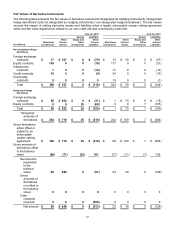Microsoft 2015 Annual Report Download - page 48
Download and view the complete annual report
Please find page 48 of the 2015 Microsoft annual report below. You can navigate through the pages in the report by either clicking on the pages listed below, or by using the keyword search tool below to find specific information within the annual report.47
Revenue for retail packaged products, products licensed to original equipment manufacturers (“OEMs”), and
perpetual licenses under certain volume licensing programs generally is recognized as products are shipped or made
available.
Technology guarantee programs are accounted for as multiple-element arrangements as customers receive free or
significantly discounted rights to use upcoming new versions of a software product if they license existing versions of
the product during the eligibility period. Revenue is allocated between the existing product and the new product, and
revenue allocated to the new product is deferred until that version is delivered. The revenue allocation is based on
the VSOE of fair value of the products. The VSOE of fair value for upcoming new products are based on the price
determined by management having the relevant authority when the element is not yet sold separately, but is
expected to be sold in the near future at the price set by management.
Software updates that will be provided free of charge are evaluated on a case-by-case basis to determine whether
they meet the definition of an upgrade and create a multiple-element arrangement, which may require revenue to be
deferred and recognized when the upgrade is delivered, or if it is determined that implied post-contract customer
support (“PCS”) is being provided, the arrangement is accounted for as a multiple-element arrangement and all
revenue from the arrangement is deferred and recognized over the implied PCS term when the VSOE of fair value
does not exist. If updates are determined to not meet the definition of an upgrade, revenue is generally recognized as
products are shipped or made available.
Certain volume licensing arrangements include a perpetual license for current products combined with rights to
receive unspecified future versions of software products, which we have determined are additional software products
and are therefore accounted for as subscriptions, with billings recorded as unearned revenue and recognized as
revenue ratably over the coverage period. Arrangements that include term-based licenses for current products with
the right to use unspecified future versions of the software during the coverage period, are also accounted for as
subscriptions, with revenue recognized ratably over the coverage period.
Revenue from cloud-based services arrangements that allow for the use of a hosted software product or service over
a contractually determined period of time without taking possession of software are accounted for as subscriptions
with billings recorded as unearned revenue and recognized as revenue ratably over the coverage period beginning
on the date the service is made available to customers. Revenue from cloud-based services arrangements that are
provided on a consumption basis (for example, the amount of storage used in a particular period) is recognized
commensurate with the customer utilization of such resources.
Some volume licensing arrangements include time-based subscriptions for cloud-based services and software
offerings that are accounted for as subscriptions. These arrangements are considered multiple-element
arrangements. However, because all elements are accounted for as subscriptions and have the same coverage
period and delivery pattern, they have the same revenue recognition timing.
Revenue related to phones, Surface devices, Xbox consoles, games published by us, and other hardware
components is generally recognized when ownership is transferred to the resellers or to end customers when selling
directly through Microsoft retail stores and online marketplaces. A portion of revenue may be deferred when these
products are combined with software elements, and/or services. Revenue related to licensing for games published by
third parties for use on the Xbox consoles is recognized when games are manufactured by the game publishers.
Display advertising revenue is recognized as advertisements are displayed. Search advertising revenue is
recognized when the ad appears in the search results or when the action necessary to earn the revenue has been
completed. Consulting services revenue is recognized as services are rendered, generally based on the negotiated
hourly rate in the consulting arrangement and the number of hours worked during the period. Consulting revenue for
fixed-price services arrangements is recognized as services are provided. Revenue from prepaid points redeemable
for the purchase of software or services is recognized upon redemption of the points and delivery of the software or
services.
Cost of Revenue
Cost of revenue includes: manufacturing and distribution costs for products sold and programs licensed; operating
costs related to product support service centers and product distribution centers; costs incurred to include software
on PCs sold by OEMs, to drive traffic to our websites, and to acquire online advertising space; costs incurred to
support and maintain Internet-based products and services, including datacenter costs and royalties; warranty costs;
inventory valuation adjustments; costs associated with the delivery of consulting services; and the amortization of
capitalized software development costs. Capitalized software development costs are amortized over the estimated
lives of the products.


